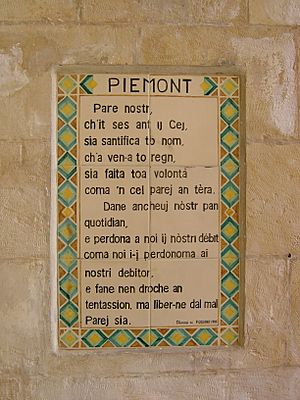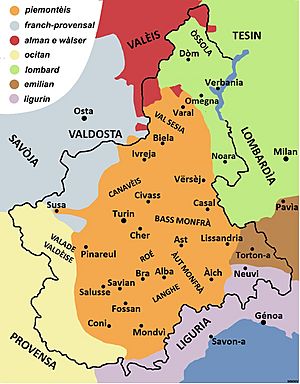Piedmontese language facts for kids

The Piedmontese language is a special language spoken in the Piedmont region of Italy. It's part of a group called Gallo-Romance languages. In the 1980s, the Council of Europe officially recognized Piedmontese as a minority language. This means it's a language spoken by a smaller group of people in a country where another language is more common. Sadly, it's now considered an endangered language, which means fewer and fewer people are speaking it. In 2019, there were between 700,000 and 2 million people who spoke Piedmontese.
Piedmontese has a long history, being used since the 12th century. People have written poems and literature in Piedmontese since the 16th century. However, around the 15th or 16th century, local leaders started using the Italian language more, which is based on dialects from the Tuscany region. When Italy became a united country in 1861, Italian was chosen as the national language. As cities grew and mass media like radio and TV became popular, Italian became even more widespread, and Piedmontese was used less often.
Contents
What is Piedmontese?
Piedmontese is a Romance language, which means it developed from Latin, just like Italian, French, and Spanish. It has some unique sounds and words that make it different from other languages. For example, it uses special sounds that are not found in Italian.
Where is Piedmontese Spoken?
Piedmontese is mainly spoken in the Piedmont region, which is in the northwest part of Italy. This region is known for its beautiful mountains and delicious food. While Italian is the main language taught in schools and used in daily life, Piedmontese is still spoken by many families, especially older generations.
A Language with History
Piedmontese has a rich history that goes back many centuries. It was once the main language of the Duchy of Savoy, a powerful state that existed before modern Italy.
Early Beginnings
The first written examples of Piedmontese appeared in the 12th century. Over time, it developed its own grammar and vocabulary. Many important documents and literary works were written in Piedmontese during the Middle Ages and the Renaissance.
Literature and Culture
From the 16th century onwards, many writers created beautiful literature in Piedmontese. These works include poems, plays, and stories that reflect the culture and traditions of the Piedmont region. Even today, some authors continue to write in Piedmontese, keeping the language alive through their art.
Why is it Endangered?
A language becomes endangered when fewer and fewer people learn and speak it. Several things have contributed to Piedmontese becoming an endangered language.
The Rise of Italian
When Italy became a unified country in 1861, the government chose Italian as the official national language. This meant that Italian was used in schools, government, and media across the country. This made it harder for regional languages like Piedmontese to thrive.
Modern Challenges
In modern times, urbanization (when people move from the countryside to cities) and the spread of mass media (like television and radio) have also played a big role. Italian became the language of popular culture and wider communication, making it seem more important for people to learn and use. As a result, many younger people did not learn Piedmontese from their parents or grandparents, leading to a decline in speakers.
Efforts to Preserve Piedmontese
Even though Piedmontese is endangered, there are people and groups working hard to keep it alive.
Official Recognition
The recognition of Piedmontese as a minority language by the Council of Europe in the 1980s was an important step. This helped to acknowledge the language's importance and encourage efforts to protect it.
Teaching and Promotion
Some schools and cultural organizations in Piedmont offer classes to teach Piedmontese to children and adults. There are also efforts to promote the language through local media, music, and cultural events. These activities help to raise awareness and encourage new generations to learn and appreciate this unique part of their heritage.
See also
- Idioma piamontés para niños (Piedmontese language for kids in Spanish)


